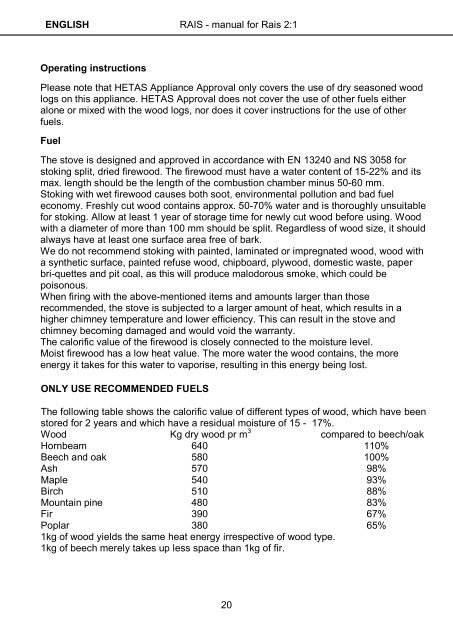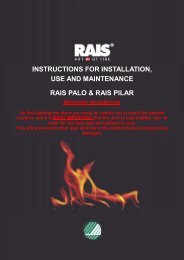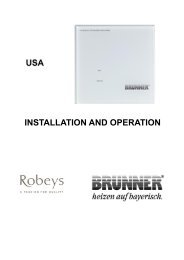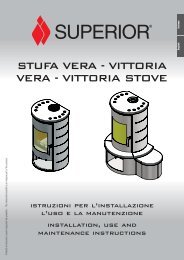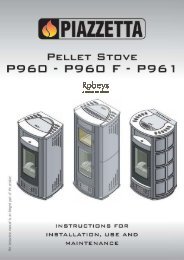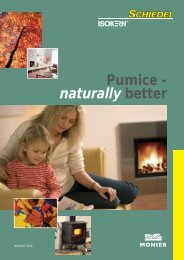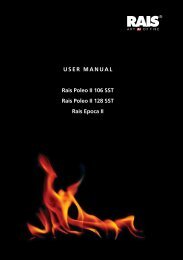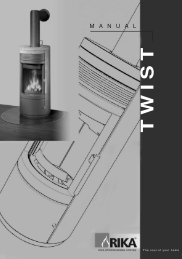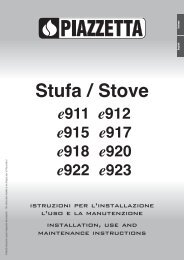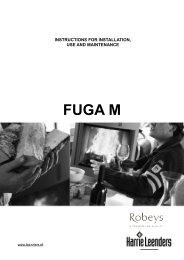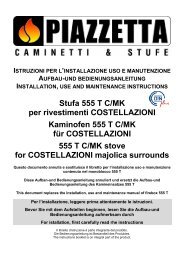instructions for installation, use and maintenance rais 2:1 - Robeys Ltd
instructions for installation, use and maintenance rais 2:1 - Robeys Ltd
instructions for installation, use and maintenance rais 2:1 - Robeys Ltd
- No tags were found...
Create successful ePaper yourself
Turn your PDF publications into a flip-book with our unique Google optimized e-Paper software.
ENGLISH RAIS manual <strong>for</strong> Rais 2:1<br />
Operating <strong>instructions</strong><br />
Please note that HETAS Appliance Approval only covers the <strong>use</strong> of dry seasoned wood<br />
logs on this appliance. HETAS Approval does not cover the <strong>use</strong> of other fuels either<br />
alone or mixed with the wood logs, nor does it cover <strong>instructions</strong> <strong>for</strong> the <strong>use</strong> of other<br />
fuels.<br />
Fuel<br />
The stove is designed <strong>and</strong> approved in accordance with EN 13240 <strong>and</strong> NS 3058 <strong>for</strong><br />
stoking split, dried firewood. The firewood must have a water content of 1522% <strong>and</strong> its<br />
max. length should be the length of the combustion chamber minus 5060 mm.<br />
Stoking with wet firewood ca<strong>use</strong>s both soot, environmental pollution <strong>and</strong> bad fuel<br />
economy. Freshly cut wood contains approx. 5070% water <strong>and</strong> is thoroughly unsuitable<br />
<strong>for</strong> stoking. Allow at least 1 year of storage time <strong>for</strong> newly cut wood be<strong>for</strong>e using. Wood<br />
with a diameter of more than 100 mm should be split. Regardless of wood size, it should<br />
always have at least one surface area free of bark.<br />
We do not recommend stoking with painted, laminated or impregnated wood, wood with<br />
a synthetic surface, painted ref<strong>use</strong> wood, chipboard, plywood, domestic waste, paper<br />
briquettes <strong>and</strong> pit coal, as this will produce malodorous smoke, which could be<br />
poisonous.<br />
When firing with the abovementioned items <strong>and</strong> amounts larger than those<br />
recommended, the stove is subjected to a larger amount of heat, which results in a<br />
higher chimney temperature <strong>and</strong> lower efficiency. This can result in the stove <strong>and</strong><br />
chimney becoming damaged <strong>and</strong> would void the warranty.<br />
The calorific value of the firewood is closely connected to the moisture level.<br />
Moist firewood has a low heat value. The more water the wood contains, the more<br />
energy it takes <strong>for</strong> this water to vaporise, resulting in this energy being lost.<br />
ONLY USE RECOMMENDED FUELS<br />
The following table shows the calorific value of different types of wood, which have been<br />
stored <strong>for</strong> 2 years <strong>and</strong> which have a residual moisture of 15 17%.<br />
Wood Kg dry wood pr m 3 compared to beech/oak<br />
Hornbeam 640 110%<br />
Beech <strong>and</strong> oak 580 100%<br />
Ash 570 98%<br />
Maple 540 93%<br />
Birch 510 88%<br />
Mountain pine 480 83%<br />
Fir 390 67%<br />
Poplar 380 65%<br />
1kg of wood yields the same heat energy irrespective of wood type.<br />
1kg of beech merely takes up less space than 1kg of fir.<br />
20


